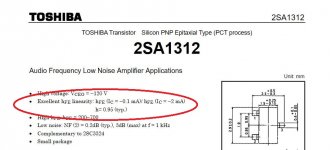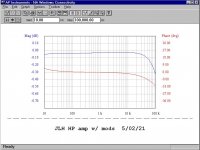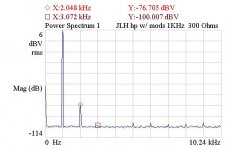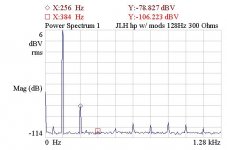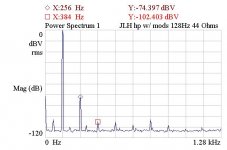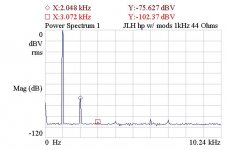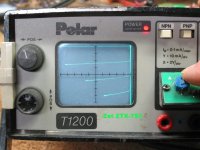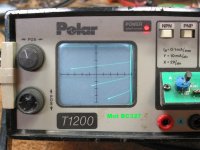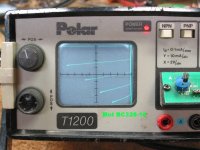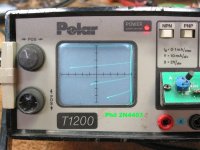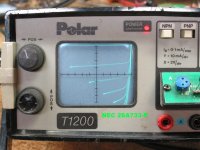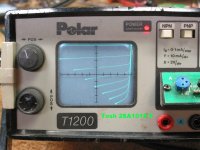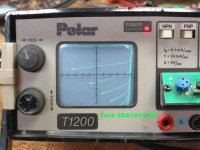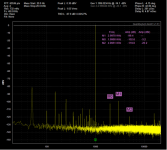I guess it's a much better fit with my own intuition, to talk about "constant beta" rather than "gain linearity", since linear equations practically never have zero slope.
"linearity" means that the derivative of (Thing1) is constant with respect to (Thing2). Thing1 is a linear function of Thing2. But when the hoped-for linear function is
I kind of feel that it's misleading to talk about the "linearity" of Thing1. You want Thing1 to be CONSTANT, not linearly proportional.
"linearity" means that the derivative of (Thing1) is constant with respect to (Thing2). Thing1 is a linear function of Thing2. But when the hoped-for linear function is
- Thing1 = (0 x Thing2) + Constant
I kind of feel that it's misleading to talk about the "linearity" of Thing1. You want Thing1 to be CONSTANT, not linearly proportional.
Your semantic objection is noted. However, a line with no slope is still a line...
Also, I did not invent the term. Many others, on this website and elsewhere, have used linearity to describe relatively-constant-beta devices.
Moving on... I think I'm at or near the end-of-the-line for mods on this amp, so I did extensive listening last night compared to my TPA6120-based one. Both are set up with 1 Ohm output resistors and no Zobel. The 6120 has 2200uF DC-blocking caps on the outputs.
Bottom line: They are both excellent, and I'll take one of each, thank you. Brief comments:
Tonally, the JLH has a bit of "smily-face" going on; a tad fatter bottom and more edge on the highs. So it always wins on first impressions (ask JBL if smiley-face response sells...) In the imaging department, its presentation is a bit clearer in the lower mids and overall more spacious. Very nice. Some headphones benefit greatly from these characteristics; the classic 600-Ohm AKG K240DF's in particular really shine with this amp and sound almost electrostatic-like. The Sennheiser 560 and 580 are already a bit overweight on the bottom, so unless the recording is low-end-weak (like many oldies are), they match up better with the 6120.
The 6120 is better in the upper 2-3 octaves; smooth yet detailed. My impression is, of the two, the 6120 is overall the more "honest". Compression artifacts are less offensive with it.
If you strapped me to a chair and told me, as punishment for past transgressions, I had to choose only one of these amps to use for the rest of my life, I'd probably take the 6120. It requires little or no warmup time and sounds better with a wide variety of headphones and source material (i.e. codecs...). Plus, the layout of the 6120 board sux even worse than the JLH's, and I think there is a bit more to be coaxed from it.
I still need an amp for my 44-Ohm 'phones.
Will make some measurements later.
OK, here are a bunch of mesurements.
First, for the time-domain-ophiles, leading and trailing edges are clean and symmetrical. No issues from the lower gain. The little seemingly-random packets of noise on the trace are interesting - this was done completely unshielded sitting on my test bench. Maybe they're wifi packets from the transmitter sitting 12 feet away?
Then freq response 10Hz-100kHz. This is an upclose look, 0.1dB/div. There is the slightest of upward tilts in the spectrum. And despite moving the feedback cap value down well below 1Hz, there is still some phase shift at low freqs. A few degrees may not sound like much, but every degree at 50Hz translates into a .75" spatial displacement. Probably more audible with headphones than with speakers in a room.
First, for the time-domain-ophiles, leading and trailing edges are clean and symmetrical. No issues from the lower gain. The little seemingly-random packets of noise on the trace are interesting - this was done completely unshielded sitting on my test bench. Maybe they're wifi packets from the transmitter sitting 12 feet away?
Then freq response 10Hz-100kHz. This is an upclose look, 0.1dB/div. There is the slightest of upward tilts in the spectrum. And despite moving the feedback cap value down well below 1Hz, there is still some phase shift at low freqs. A few degrees may not sound like much, but every degree at 50Hz translates into a .75" spatial displacement. Probably more audible with headphones than with speakers in a room.
Attachments
Now some distortion spectra. For comparison, the orgiinal measurements I made are here:
JLH Headphone Amp
They were after fixing the grounding issue, but mostly stock otherwise. I didn't post 100Hz measurements (128Hz, actually) then because they were identical to the 1kHz ones.
Into 300 Ohms, here are 1kHz and 128Hz. Distortion is 1.5dB worse at 1Khz. The noise floor dropped a couple dB, which is good.
Distortion at 128Hz measures a couple dB better than before. Certainly not enough to explain the improvement in sound, though. Except for the 60Hz, powerline harmonics are buried in the noise, so the grounding scheme works well.
JLH Headphone Amp
They were after fixing the grounding issue, but mostly stock otherwise. I didn't post 100Hz measurements (128Hz, actually) then because they were identical to the 1kHz ones.
Into 300 Ohms, here are 1kHz and 128Hz. Distortion is 1.5dB worse at 1Khz. The noise floor dropped a couple dB, which is good.
Distortion at 128Hz measures a couple dB better than before. Certainly not enough to explain the improvement in sound, though. Except for the 60Hz, powerline harmonics are buried in the noise, so the grounding scheme works well.
Attachments
Being a time-domain-ophile, I like to look at two square wave responses.
#1 is the J. Peter Moncrieff response: Apply 19 Hertz square wave input with sub-5-microsecond risetime and fall time. Plot output. Does the output "square wave" flat top and flat bottom exhibit any droop at all? (is there any DC servo at all?) If there's droop, is the output waveshape "flat top" error: linear, quadratic, exponential, or dogmeat?
#2 is the Nelson Pass response: Apply 200 kHz square wave input at sufficiently low amplitude (< 100 mV pk-pk for amps made with all-BJTs) to avoid hard slewing. Input risetime and fall time should be sub-5-NANOseconds so this requires a dedicated piece of professional test gear not a dormitory freshman's Android phone with an app. Plot the output. Is there overshoot? Slow or VERY slow settling to 1% and 0.1%?
#1 is the J. Peter Moncrieff response: Apply 19 Hertz square wave input with sub-5-microsecond risetime and fall time. Plot output. Does the output "square wave" flat top and flat bottom exhibit any droop at all? (is there any DC servo at all?) If there's droop, is the output waveshape "flat top" error: linear, quadratic, exponential, or dogmeat?
#2 is the Nelson Pass response: Apply 200 kHz square wave input at sufficiently low amplitude (< 100 mV pk-pk for amps made with all-BJTs) to avoid hard slewing. Input risetime and fall time should be sub-5-NANOseconds so this requires a dedicated piece of professional test gear not a dormitory freshman's Android phone with an app. Plot the output. Is there overshoot? Slow or VERY slow settling to 1% and 0.1%?
Into 44 Ohms we see some definite improvement.
At 1kHz, H2 is 5dB lower. And at 128Hz it is 4dB lower than before. This correlates with what I hear, the modded amp does sound better with the 44 Ohm 'phones.
So except for the 44 Ohm results, I have to say that these measurements do not capture the magnitude of improvement in sound that has occured from these mods. Which is a bit of a disappointment.
At 1kHz, H2 is 5dB lower. And at 128Hz it is 4dB lower than before. This correlates with what I hear, the modded amp does sound better with the 44 Ohm 'phones.
So except for the 44 Ohm results, I have to say that these measurements do not capture the magnitude of improvement in sound that has occured from these mods. Which is a bit of a disappointment.
Attachments
The bench mark I use for headphone amp is better than -90dB THD at 1Vrms 1kHz into 32R.
Pass Labs HPA-1 headphone amplifier Measurements | Stereophile.com
Patrick
Pass Labs HPA-1 headphone amplifier Measurements | Stereophile.com
Patrick
Being a time-domain-ophile, I like to look at two square wave responses.
Looks like DC-to-light tests 🙂
#1 is the J. Peter Moncrieff response:
Peter was a smart guy. And a good person too. What's he up to these days?
The bench mark I use for headphone amp is better than -90dB THD at 1Vrms 1kHz into 32R.
[/url]
That seems like a reasonable goal.
The NEC 2SA733-P's arrived yesterday. I decided to do some measurements before listening, and tested Hfe vs Vce for gain linearity.
I started with the Toshiba 2SA1015-GR, which I've been listening to for a couple days now. The nonlinearity was obvious. This looks like a "constant compression" device. Quite contrary to the data sheet curves.
So I decided to look at a bunch of various PNP's that would be possible candidates for the input position. Pics are labeled.
: Toshiba 2SA1015-GR
: Toshiba 2SA1015-Y
: NEC 2SA733-P
: Philips 2N4403
: Motorola BC328-16
: Motorola BC327
: Zetex ZTX753
Continued next post
I started with the Toshiba 2SA1015-GR, which I've been listening to for a couple days now. The nonlinearity was obvious. This looks like a "constant compression" device. Quite contrary to the data sheet curves.
So I decided to look at a bunch of various PNP's that would be possible candidates for the input position. Pics are labeled.
: Toshiba 2SA1015-GR
: Toshiba 2SA1015-Y
: NEC 2SA733-P
: Philips 2N4403
: Motorola BC328-16
: Motorola BC327
: Zetex ZTX753
Continued next post
Attachments
Last edited:
2nd pic is the Y grade A1015. Nonlinearity is much improved but still present.
3rd pic is the NEC A733-P. Much better than the 1015-GR.
4th pic is a NOS Philips-branded 2N4403 from a sampler pack that I got 20+ years ago. Linearity is better still.
5th pic is a Motorola BC328-16. A little lower Hfe but decent.
6th pic is a Motorola BC327. Looks almost exactly like the 2N4403.
Last pic is a Zetex ZTX-753. I don't know if it is a possibility for the input, I don't have noise specs for it, but it has the best linearity of the bunch.
I installed a couple of the NEC A733's into the amp, and the tonal character was much improved. The clarity and openness now extended up into the midrange. Gone was the "smiley face" fat bass and edgy highs. That was all being caused by the A1015-GR.
I wouldn't be surprised if the 2SA970 was the same. The data sheet Hfe curves are the same as the 1015.
So the A733 is a much better transistor for this purpose. But having heard now what difference the gain linearity makes, I'm pretty sure even it can be improved upon.
My sense is, the high-Hfe grades of these transistors are well-suited for low-level signals. But with 2+VRMS at the input, linearity matters more.
Your thoughts?
3rd pic is the NEC A733-P. Much better than the 1015-GR.
4th pic is a NOS Philips-branded 2N4403 from a sampler pack that I got 20+ years ago. Linearity is better still.
5th pic is a Motorola BC328-16. A little lower Hfe but decent.
6th pic is a Motorola BC327. Looks almost exactly like the 2N4403.
Last pic is a Zetex ZTX-753. I don't know if it is a possibility for the input, I don't have noise specs for it, but it has the best linearity of the bunch.
I installed a couple of the NEC A733's into the amp, and the tonal character was much improved. The clarity and openness now extended up into the midrange. Gone was the "smiley face" fat bass and edgy highs. That was all being caused by the A1015-GR.
I wouldn't be surprised if the 2SA970 was the same. The data sheet Hfe curves are the same as the 1015.
So the A733 is a much better transistor for this purpose. But having heard now what difference the gain linearity makes, I'm pretty sure even it can be improved upon.
My sense is, the high-Hfe grades of these transistors are well-suited for low-level signals. But with 2+VRMS at the input, linearity matters more.
Your thoughts?
Last edited:
Were you measuring hfe vs Ic, or were you measuring Ic vs Vce (saturation & Early effect) ?
Patrick
Patrick
As a bench mark, this is built using 2SA1312BL / 2SC3324BL (SMD version of 2SA970BL / 2SC2240BL).
Output transistors are Sanken 2SA1859A / 2SC4883A.
1Vrms 1kHz into 32R.
And that achieved without using global negative feedback.
The Pioneer Super Linear Circuit
Cheers,
Patrick
.
Output transistors are Sanken 2SA1859A / 2SC4883A.
1Vrms 1kHz into 32R.
And that achieved without using global negative feedback.
The Pioneer Super Linear Circuit
Cheers,
Patrick
.
Attachments
The plots show both, don't they?
Saturation and recovery from the extension and return of each line, and Hfe vs Ic by the spacing between the lines at a given Vce.
Your plot is too small to read any numbers.
Saturation and recovery from the extension and return of each line, and Hfe vs Ic by the spacing between the lines at a given Vce.
Your plot is too small to read any numbers.
Last edited:
Horowitz and Hill performed their own measurements of Beta versus Ic, and published the plots in their book "The Art Of Electronics", third edition.
The PNPs whose (Beta vs. Ic) curves look the absolute flattest in their tests, in my opinion, appear to be
2SB1690K, 2N5087, 2SA1312, 2SB1197KR, 2SB1241, 2SA1175, MPS8599
The PNPs whose (Beta vs. Ic) curves look the absolute flattest in their tests, in my opinion, appear to be
2SB1690K, 2N5087, 2SA1312, 2SB1197KR, 2SB1241, 2SA1175, MPS8599
And for clarity, all those 50Hz multiples were due to a simple lab power supply used during the measurement.
Patrick
Patrick
Horowitz and Hill performed their own measurements of Beta versus Ic, and published the plots in their book "The Art Of Electronics", third edition.
The PNPs whose (Beta vs. Ic) curves look the absolute flattest in their tests, in my opinion, appear to be
2SB1690K, 2N5087, 2SA1312, 2SB1197KR, 2SB1241, 2SA1175, MPS8599
Thanks for that list. The 2N5087's I have here look not so great. I have some 8599's here but haven't found them yet. I'll have 1312's by Friday.
BTW, 1KHz distortion measures no different with the A733 vs the A1015. Yet the sound is markedly different.
I have no problems reading all the numbers with my 60+ year-old eyes. 😉
So I failed your reading test... big deal...
What was the input signal level and gain on your test?
Last edited:
Benchmark is, as mentioned earlier, 1Vrms 1kHz into 32R.
H2 -103dB; H3 -99dB; H4 -120dB.
Cheers,
Patrick
H2 -103dB; H3 -99dB; H4 -120dB.
Cheers,
Patrick
- Home
- Amplifiers
- Headphone Systems
- JLH Headphone Amp
